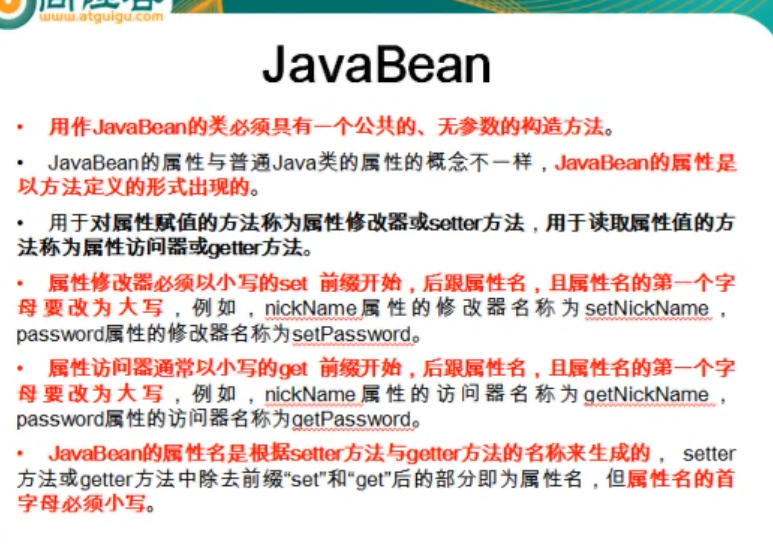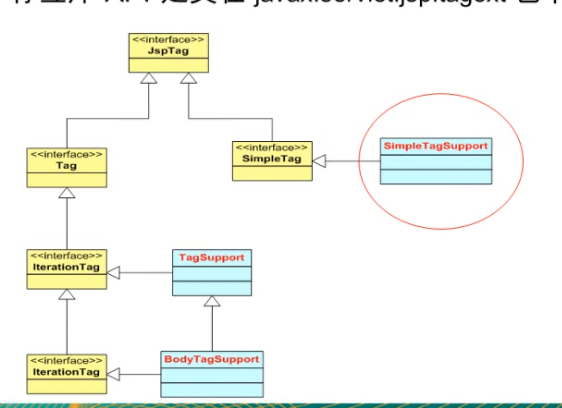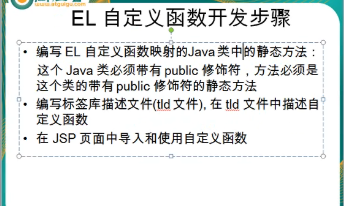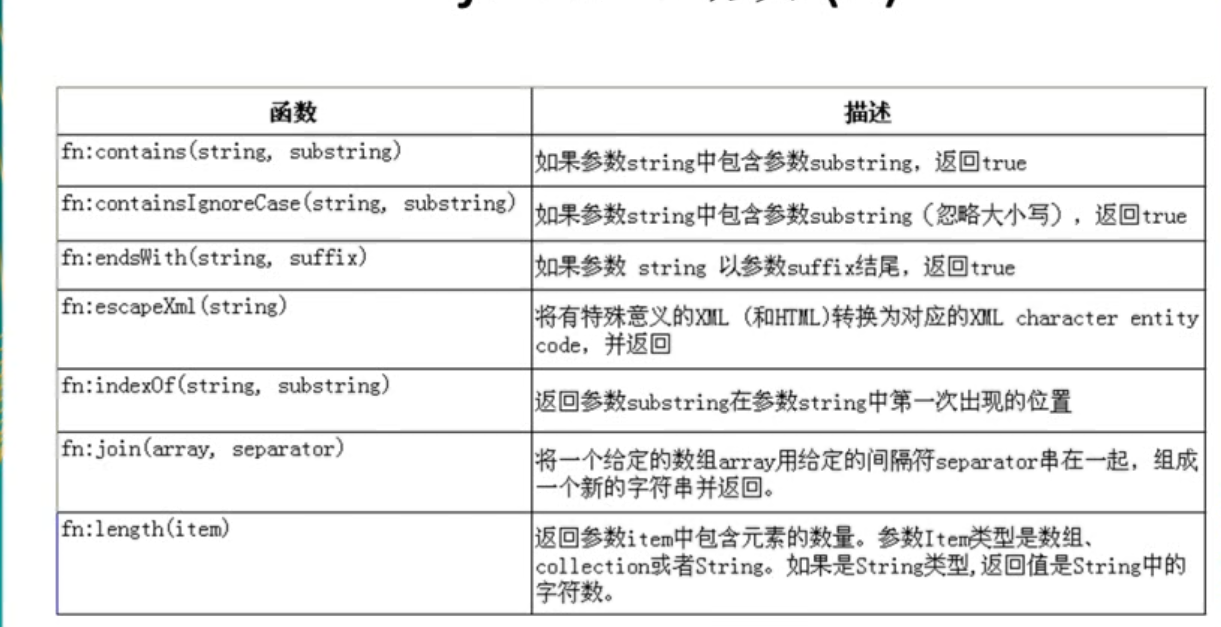1.JavaBean 必须要有一个公共的无参构造器

2. 在表单回显
"<%=request.getParameter("username")==null?"":request.getParameter("username") %>" =value=“$param.username{}” 明显简化JSP开发

3. EL提供. 和[] 两种运算符来提取数据,
[] 是为了区别 对象中属性带有特需字符 .
session.setAtrribute("com.http.mvp","value") 点的话无法进行区分

2).EL 能够进行自动类型转换,前面score=100,后者Score=8911

3) EL的隐含对象
1.与输入有关隐含对象,两个 param 和paramValues 对象
paramValues接收多个参数 不需要强制转换一直.下去就行
2.其他隐含对象 ---cookie head 和pageContext最有用pageContext
initParam获取当前WEb初始化参数,但是web.xml进行<context-param>的设定
3.EL中pageContext获取其他页面和本页面上的属性
一. 简单的标签:共同特性的tag库应用于不同的项目中,体现了软件复用的思想
1.建立一个标签处理器类servlet实现SimpleTag接口
2.建立一个.tld 文件:
1 <?xml version="1.0" encoding="UTF-8"?> 2 3 <taglib xmlns="http://java.sun.com/xml/ns/j2ee" 4 xmlns:xsi="http://www.w3.org/2001/XMLSchema-instance" 5 xsi:schemaLocation="http://java.sun.com/xml/ns/j2ee http://java.sun.com/xml/ns/j2ee/web-jsptaglib rary_2_0.xsd" 6 version="2.0"> 7 8 <description>JSTL 1.1 core library</description> 9 <display-name>MyTag core</display-name> 10 <tlib-version>1.1</tlib-version> 11 12 <!-- 建议JSP页面上使用的名称 --> 13 <short-name>atGuiGu</short-name> 14 15 <!-- TLD 文件的ID唯一标识当前TLD文件,多个TLD URI不能重复 --> 16 <uri>http:// www.atguigu.com/myTag/core</uri> 17 </taglib>
3.进行描述标签操作

4. 在JSP页面上进行导入 完成自定义标签的使用




2. 标签的属性: 属性必须要在.tld 文件中设定:只有先设定才能够获取
如果是简单的标签的直接可以实现 SimpleTagSupport 就行
1 <attribute>
<!--z注意必须要与 标签处理器类中 setter方法定义属性相同--> 2 <name>value</name> 3 <required>true</required> 4 <!-- 当前属性是否接受动态值 --> 5 <rtexprvalue>true</rtexprvalue> 6 </attribute>
3.JSP中设定带属性:
<atGuiGu:hello value="${param.name }" count="10"/>
之下代码 先在TLD文件设定属性,同时标签处理器类 设定setter和getter方法
1 <?xml version="1.0" encoding="UTF-8"?> 2 3 <taglib xmlns="http://java.sun.com/xml/ns/j2ee" 4 xmlns:xsi="http://www.w3.org/2001/XMLSchema-instance" 5 xsi:schemaLocation="http://java.sun.com/xml/ns/j2ee http://java.sun.com/xml/ns/j2ee/web-jsptaglibrary_2_0.xsd" 6 version="2.0"> 7 8 <description>JSTL 1.1 core library</description> 9 <display-name>MyTag core</display-name> 10 <tlib-version>1.1</tlib-version> 11 12 <!-- 建议JSP页面上使用的名称 --> 13 <short-name>atGuiGu</short-name> 14 15 <!-- TLD 文件的ID唯一标识当前TLD文件,多个TLD URI不能重复 --> 16 <uri>http:// www.atguigu.com/myTag/core</uri> 17 18 <!-- 描述TLD文件 --> 19 20 <tag> 21 <!-- 标签名 --> 22 <name>hello</name> 23 <!-- 标签 所在的全类名 --> 24 <tag-class> com.atug.taglib.HelloSimpTag</tag-class> 25 <!-- 标签体全类型 --> 26 <body-content>empty</body-content> 27 28 <!-- 描述当前的属性 --> 29 <attribute>
30 <name>value</name> 31 <required>true</required> 32 <!-- 当前属性是否接受动态值 --> 33 <rtexprvalue>true</rtexprvalue> 34 </attribute> 35 <attribute> 36 <name>count</name> 37 <required>false</required> 38 <!-- 当前属性是否接受动态值 --> 39 <rtexprvalue>false</rtexprvalue> 40 </attribute> 41 </tag> 42 43 </taglib>

1 public class HelloSimpTag implements SimpleTag { 2 private String count; 3 private String value; 4 public String getCount() { 5 return count; 6 } 7 8 public void setCount(String name) { 9 this.count = name; 10 } 11 12 public String getValue() { 13 return value; 14 } 15 16 public void setValue(String value) { 17 this.value = value; 18 } 19 20 public PageContext getPageContext() { 21 return pageContext; 22 } 23 24 public void setPageContext(PageContext pageContext) { 25 this.pageContext = pageContext; 26 } 27 28 @Override 29 public void doTag() throws JspException, IOException { 30 // TODO Auto-generated method stub 31 System.out.println(value +" "+count); 32 33 HttpServletRequest request=(HttpServletRequest) pageContext.getRequest(); 34 pageContext.getOut().print("hello"+request.getAttribute("name")); 35 36 } 37 38 @Override 39 public JspTag getParent() { 40 // TODO Auto-generated method stub 41 return null; 42 } 43 44 @Override 45 public void setJspBody(JspFragment arg0) { 46 // TODO Auto-generated method stub 47 48 } 49 private PageContext pageContext=null; 50 // JSp引擎调用 得到其他的8个JSP的内置对象 51 @Override 52 public void setJspContext(JspContext arg0) { 53 // TODO Auto-generated method stub 54 this.pageContext=(PageContext) arg0; 55 } 56 57 @Override 58 public void setParent(JspTag arg0) { 59 // TODO Auto-generated method stub 60 61 } 62 63 }
 明显在doTage方法获取到来有JSP页面设定的属性
明显在doTage方法获取到来有JSP页面设定的属性

开发父标签 子标签将父标签的属性在JSP页面显示 注意父标签必须是 JSP Tag接口 getJspContext()方法相当于PageContext ,让JSP页面使用某个对象必须用Tomcat内置的JspContext.setAttribute()进行对象设定
JspContext是继承SimpleTagSupport类
1)父标签无法获取子标签的引用
2)子标签通过getParent() 方法获取父标签(继承SimpleTag)
1.ParentTag parentTag=(ParentTag)getParent();
2.获取父标签属性 String name=parentTag.getName();
7.开发一个标签能够实现
1 <%@ taglib prefix="c" uri="http://java.sun.com/jsp/jstl/core"%>
1 <c:choose> 2 <c:when test="${param.age > 24 }">大学毕业</c:when> 3 <c:when test="${param.age > 20 }">高中毕业</c:when> 4 <c:otherwise>高中之下...</c:otherwise> 5 </c:choose> 6
当然下C标签下有这样的一个标签,但是编写属于自己的choose,when,otherwise功能:
步骤:
--> when 标签有一个boolean 类型属性test
--> choose 是when 和otherwise的父标签,when在otherwise之前使用
---> 在父标签choose中定义全局变量 Boolean 的flag ,用于判断子标签满足条件下是否执行,相当于swithch break一样
当执行完成之后不往下执行
当 when d的test是true并且when的父标签flag也是true 执行when标签
when test=true,choose flag=false 不执行标签体
when test=false,choose flag=true,执行otherwise标签
1.when 标签: getJspBody()。invoke(null): 将标签中内容输出到JSP页面上

1 package com.atug.taglib; 2 3 import java.io.IOException; 4 5 import javax.servlet.jsp.JspException; 6 import javax.servlet.jsp.tagext.SimpleTagSupport; 7 8 public class ChooseTag extends SimpleTagSupport { 9 private boolean flag=true; 10 11 public boolean isFlag() { 12 return flag; 13 } 14 15 public void setFlag(boolean flag) { 16 this.flag = flag; 17 } 18 19 // 父标签之言子标签自己之下就ok 20 @Override 21 public void doTag() throws JspException, IOException 22 { 23 getJspBody().invoke(null); 24 } 25 26 }

1 package com.atug.taglib; 2 3 import java.io.IOException; 4 5 import javax.servlet.jsp.JspException; 6 import javax.servlet.jsp.tagext.SimpleTagSupport; 7 //开发简单标签 用simpleTagSupport 8 public class WhenTag extends SimpleTagSupport{ 9 10 private boolean test; 11 12 public boolean isTest() { 13 return test; 14 } 15 16 public void setTest(boolean test) { 17 this.test = test; 18 } 19 20 @Override 21 public void doTag() throws JspException, IOException 22 { 23 if(test) 24 {// test 值右 param.age>24 算术判断 25 // 获取父标签的 flag 属性 26 ChooseTag chooseTag= (ChooseTag) getParent(); 27 boolean flag=chooseTag.isFlag(); 28 29 if(flag) 30 { 31 // 那么将标签体的内容默认输出到浏览器显示 32 getJspBody().invoke(null); 33 //执行比较完成之后将本个when关闭 34 chooseTag.setFlag(false); 35 } 36 } 37 } 38 }

1 package com.atug.taglib; 2 3 import java.io.IOException; 4 5 import javax.servlet.jsp.JspException; 6 import javax.servlet.jsp.tagext.SimpleTagSupport; 7 8 public class OtherwiseTag extends SimpleTagSupport { 9 @Override 10 public void doTag() throws JspException, IOException { 11 12 ChooseTag chooseTag=(ChooseTag) getParent(); 13 14 if(chooseTag.isFlag()) 15 { 16 getJspBody().invoke(null); 17 } 18 } 19 }
TLD.文件上配置:

1 <tag> 2 <name>choose</name> 3 <tag-class>com.atug.taglib.ChooseTag</tag-class> 4 <body-content>scriptless</body-content> 5 </tag> 6 7 <tag> 8 <name>when</name> 9 <tag-class>com.atug.taglib.WhenTag</tag-class> 10 <body-content>scriptless</body-content> 11 12 <attribute> 13 <name>test</name> 14 <required>true</required> 15 <rtexprvalue>true</rtexprvalue> 16 </attribute> 17 </tag> 18 <tag> 19 <name>otherwise</name> 20 <tag-class>com.atug.taglib.OtherwiseTag</tag-class> 21 <body-content>scriptless</body-content> 22 </tag>

1 <atGuiGu:choose> 2 <atGuiGu:when test="${param.age > 24 }">大学毕业</atGuiGu:when> 3 <atGuiGu:when test="${param.age > 20 }">高中毕业</atGuiGu:when> 4 <atGuiGu:otherwise>高中之下</atGuiGu:otherwise> 5 </atGuiGu:choose> 6 7
8.EL的自定义函数:
步骤:
1.编写Java类的静态方法 必须public修饰静态方法
2.tld文件中进行说明
1 <function> 2 <name>concat</name> 3 <function-class>com.atug.taglib.MyELFunction</function-class> 4 <function-signature>java.lang.String concat(java.lang.String,java.lang.String)</function-signature> 5 </function>



